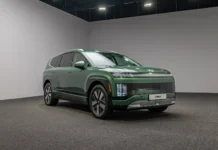
Is the Hyundai Sonata Hybrid Better than the Hybrid Plug-in?
This year Hyundai offers both a hybrid and hybrid plug-in version of their popular Sonata sedan. The second generation 2016 Hyundai Sonata Hybrid has been updated with better fuel economy and lower emissions than the 2015 model that was still using the previous generation body style. The Sonata Hybrid Plug-in is Hyundai’s first ever PHEV (plug-in hybrid electric vehicle). Hybrid or hybrid plug-in, which is the right fuel-sipper for you? We attempt to clarify the differences between the two hybrid sedans from Hyundai.
Now that it is available in the sleeker, more aerodynamic body of the new generation Sonata, Hyundai wanted to improve upon the hybrid’s core competency – fuel economy. The 2016 Sonata hybrid is rated at 42 mpg combined (40 mpg city, 44 mpg highway) and earns a 10 percent improvement over the 2015 model. That is an improvement of 4 mpg over last year’s model for city, highway and combined mpg.

Responsible for the 2016 Sonata Hybrid’s notable improvement in fuel economy is 2.0-liter GDI four-cylinder that produces 154 horsepower and 140 lb-ft of torque. Strengthened with a 51 horsepower electric motor and 56 kW polymer-cased lithium-ion battery, the hybrid system delivers a total of 193 horsepower. Contributing to the hybrid sedan’s jump in better mpg is the use of lighter, stronger materials in a package that has a slippery drag coefficient of 0.24.
The hybrid plug-in model has the advantage of driving 100% emission-free on only electric power for short trips. It has the same engine as the hybrid model, but a stronger electric motor that produces 67 horsepower and brings the overall performance to 202 horsepower. The battery, which can be recharged in approximately three hours when connected to a 220 volt source, outputs 68 kWh instead of 56 kWh. In full electric mode, the Sonata Hybrid Plug-in has a top speed of 75 mph and an EV range around 24 miles. Hyundai estimates combined fuel economy at 40 mpg. Comparably, the Ford Fusion Energi PHEV has an EV range of 21 miles and the Honda Accord Plug-in Hybrid has maximum EV range of 13 miles or less.
| Hyundai Sonata Hybrid Plug-in | Ford Fusion Energi | Honda Accord Plug-in Hybrid | Toyota Prius Plug-in Hybrid | |
| Total Combined System Horsepower | 204 | 188 | 196 | 134 |
| Electric-Only MPG of Gasoline Equivalent (MPGe) | 93 | 88 | 115 | 95 |
| Battery Output (kW) | 68 | 35 | 41 | 60 |
| All Electric Range (miles) | 24 | 21 | 13 | 11 |
| Estimated Fuel Economy city/hwy/combined (MPG) | na / na / 40 | 40 / 36 / 38 | 47 / 46 / 46 | na / na / 50 |
| MSRP | not available until fall 2015 | $34,025 | returning 2016 | $30,815 |
Contrary to the competition, Hyundai chose to use a 6-speed automatic transmission because it provides a more natural driving feel. While the Camry, Accord and Fusion hybrids use an electronically controlled continuously variable transmission (e-CVT) for the purpose of maximizing mpg, Hyundai has proven good fuel economy doesn’t have to come with dull and droning CVTs.
Both the Sonata Hybrid and Hybrid Plug-in models have more interior space than its competitors: Toyota Camry, Honda Accord, and Ford Fusion. Economy of space dictated that the polymer encased lithium-ion battery be tucked under the trunk floor instead of behind the rear seats. The Toyota Camry Hybrid and Ford C-Max Energi lose usable cargo space due to the size and placement of their batteries. The 2015 Camry Hybrid has trunk space comparable to the 2016 Sonata Hybrid with 13.3 cubic feet, but the pass-thru cutout from the trunk to the cabin is barely usable due to its size and shape. On the other hand, the Sonata Hybrid has a bigger pass-thru area when 60/40 split folding rear seat is dropped and cargo space grows to a grand total of 119.4 cubic feet.
The 2016 Sonata Hybrid Plug-in, with its larger battery, has a little less trunk space with only 9.9 cubic feet available. Also, the cutout for the trunk pass-thru is slightly smaller than the Sonata Hybrid’s pass-thru but still better than its class competitors. Drop the Sonata Hybrd Plug-in’s back seats and maximum cargo space grows to 116.0 cubic feet. Trunk capacity for the Ford Fusion Energi PHEV measures only 8.2 cubic feet, but it does have a sizable pass-thru cutout when the rear seats are folded.
Hyundai’s plug-in hybrid comes standard with navigation and will display energy flow and Eco information. For the hybrid model, buyers must choose the Limited w/Ultimate trim if they want the navigation package included as standard equipment.
The 2016 Sonata Hybrid has three drive modes (Eco, Normal, and Sport) to allow for a personal driving experience and more engaging driving dynamics. With the Sonata Hybrid Plug-in, the Sport mode is unavailable. This is still better than an Accord Hybrid or Fusion Hybrid of which neither offer any selective driving modes.
Consider the Sonata Plug-in Hybrid as being more environmentally friendly – it burns less fossil fuel and emits fewer hydrocarbons into the atmosphere. If you have a short commute or primarily use your car for short trips, the advantage of having an EV becomes brighter while not having to be reliant upon plugging into a charging station every 80 miles (or less). PHEVs are the next best thing to actually owning an EV.
Charging time for a full electric car – such as the Nissan Leaf – is about four hours when connected to a Level 2 (220 volt) source. Estimated charging time for the Sonata Hybrid Plug-in is around 3 hours when connected to a Level 2 charging station. The 9.8 kWh battery capacity for the Sonata PHEV means it qualifies for federal tax credits and applicable state tax credits.
 On the TFLcar scale of:
On the TFLcar scale of:
- Buy it!
- Lease it!
- Rent it!
- … or Forget it!
I give the affordable and well-equipped 2016 Hyundai Sonata Hybrid and Hybrid Plug-in cars a “Lease It!” rating. Both the Sonata Hybrid and Sonata Hybrid Plug-in have excellent mpg numbers and are perfectly capable sedans that include a number of useful features. It makes sense to lease one of these for a few years because technology and fuel economy numbers are improving at a dramatic rate as carmakers strive to meet the demanding CAFE standards.
Hyundai finally brings the improvements it made to the 2015 Sonata to the 2016 Sonata Hybrid. Watch the video to see if Emme thinks the new hybrid is just as improved (or better) than the outgoing hybrid model.
















































